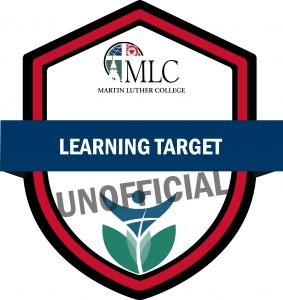MICRO-CREDENTIALS
Formal Recognition for Informal Learning
For an overview of the Learning Target Micro-Credential click on the video above. For more information see the “Resources” section below.
BDG0102 Learning Target
DESCRIPTION: Teachers who earn the Learning Target Micro-Credential can design and share learning targets to support student learning. Evidence of learning is shown through an assessment called a performance of understanding.
EARNING THE MICRO-CREDENTIAL: To earn the Learning Target Micro-Credential, teachers will demonstrate their ability to write and implement student-friendly learning targets based on national, state, or local standards or on state/local curriculum. Earners write one partial lesson plan that includes a learning target and at least one specific method of how teachers and students will share their understanding of the learning target and how they will show mastery of the learning target through an assessment. The earner will video-record the partial lesson that includes how the learning target will be introduced by the teacher, how students and teacher share their understanding of the learning target, and how it will be assessed.
RESEARCH BASE: The research for sharing learning targets or learning objectives has been demonstrated for a long time. More recently, Marzano, Pickering, and Pollock (2001) summarized research findings that showed effect sizes up to .47 and McREL’s research showed evidence of a .31 effect size (Dean, Hubbell, Pitler, & Stone, 2012).
BACKGROUND: The following are useful tools to understand more about the topic:
- Moss, C.M. & Brookhart, S.M. (2012). Learning targets: helping students aim for understanding in today’s lesson. Alexandria, VA: ASCD.
- Moss, C.M., Brookhart, S.M., & Long, B.A. (2011). Knowing your learning target. Educational Leadership 68(6), 66-69.
- McDowell, M. (2020). Making Learning Targets Clear to Students. Edutopia. Retrieved from https://www.edutopia.org/article/making-learning-targets-clear-students
MICRO-CREDENTIAL CRITERIA: A Learning Target Micro-Credential earner can do the following:
- Write learning targets based on national, state, or local standards or on state/local curriculum.
- Communicate learning targets in student-friendly language.
- Read and apply the information from the following article:
Moss, C.M., Brookhart, S.M., & Long, B.A. (2011). Knowing your learning target. Educational Leadership 68(6), 66-69. - Share learning targets in meaningful ways with the students.
- Provide evidence (performance of understanding) to show how the learning target was shared and will be assessed.
SKILL DEMONSTRATION:
- Submit a partial lesson plan that includes these parts:
- A learning target framed from a student’s point of view. See the example below and use the resources and these links to help create the learning target: Figure 1: Framing Learning Targets from a Student’s Point of View
Grade Level: 1
Subject or Topic: Language
Standard (Source): CCSS Language 2.b Use end punctuation for sentences.
Type of Target: Knowledge Target: I can use the correct end punctuation for asking and telling sentences.
Know and/or Understand: To be able to do this, I must learn and understand that periods come at the end of telling sentences and question marks come at the end of asking sentences. Telling sentences begin with words like I, we, they, my, our, their, the, that, and these. Asking sentences begin with asking words like who, what, when, where, why, and how.
Do: I will show I can do this by placing periods after telling sentences and question marks after asking sentences. I will also show this by changing telling sentences into asking sentences and asking sentences into telling sentences.
- A plan that shows how students will be helped to comprehend and share the learning target with each other and the teacher as well as how the learning target will be assessed.
- A performance of understanding (assessment) that provides evidence of how the learning target will be met.
- Submit a Lesson Video
- Video the first part of the lesson that includes the introduction of the learning target, how it will be shared, and how it will be assessed. (The video should be no longer than 10 minutes.)
- Obtain permission for the students to be video-recorded. (Use your school’s permission slip or adapt the sample permission slip given in the resources. Be sure to include a statement in your work that indicates you had permission for all students in the video.)
- Submit a Written Reflection
After recording the lesson, write a written reflection (maximum: 400 words) of the recorded lesson that explains:
- Student and teacher interactions during the process of presenting and sharing a student-friendly learning target.
- The impact on student learning when students used and shared a student-friendly learning target.
- The change/s that could be made to improve implementation, sharing, and assessing students based on the use of student-friendly learning targets.
RUBRIC:
RESOURCES:
Articles:
Brookhart, S.M., & Moss, C.M. (2014). Learning targets on parade.
Educational Leadership 72(2), 28-43.
Moss, C.M., Brookhart, S.M., & Long, B.A. (2011). Knowing your learning target.
Educational Leadership 68(6), 66-69.
Books:
Moss, C. & Brookhart, S. (2009). Advancing formative assessment in every classroom: a guide for instructional leaders. Alexandria, VA: ASCD. (Chapter 2)
Moss, C.M. & Brookhart, S.M. (2012). Learning targets: helping students aim for understanding in today’s lesson. Alexandria, VA: ASCD.
Stiggins, R. J., Arter, J. A., Chappuis, J., & Chappuis, S. (2009). Classroom assessment for learning: Doing it right—using it well. Columbus, OH: Allyn and Bacon.
Videos:
Heath H. Harmon (2017) Learning Targets: Nine Action Points
Learning Targets to Improve Student Learning
Student Friendly Learning Targets
Websites for Standards:
American Council on The Teaching of Foreign Languages
Common Core Standards: English, Language Arts, and Math
Global Teaching Learning Standards
Highscope’s Key Developmental Indicator
International Society for Technology in Education
National Curriculum for Social Studies
Next Generation Science Standards
Deconstructing (Unpacking) Standards:
Kentucky’s Deconstruction of the ELA Standards (2015)
Kentucky’s Deconstruction of the Math Standards (2015)
Common CORE State Standards (Reference to “I can” statements and Chappuis, et
al., 2012)
Webb’s Depth of Knowledge Chart (DOK) compared to Bloom’s Taxonomy
Martin Luther College Course:
EDU5106 Assessment of Learning and Instruction – 3 credits (graduate level)




